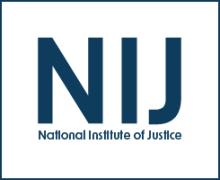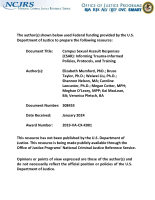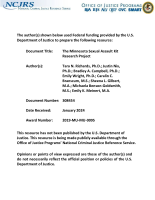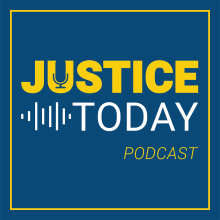Crime
Discouraging the Demand That Fosters Sex Trafficking: Collaboration through Augmented Intelligence
Journal
Date Published
2023
Agencies
NIJ-Sponsored
Publication Type
Research (Applied/Empirical)
Choosing Where to Fight: Do Social Networks Distinguish American ISIS Foreign Fighters from ISIS-Inspired Terrorists?
Journal
Date Published
2023
Agencies
NIJ-Sponsored
Publication Type
Research (Applied/Empirical)
Discouraging the Demand That Fosters Sex Trafficking: Collaboration through Augmented Intelligence
NCJ Number
308288
Journal
Societies
Date Published
2023
Agencies
NIJ-Sponsored
Publication Link
Childhood Physical Abuse (CPA), Childhood Sexual Abuse (CSA), Abusive Traumatic Brain Injury (TBI), Childhood Emotional Abuse (CEA), Neglect, and Other Trauma
Date Published
2022
Agencies
NIJ-Sponsored
Publication Type
Report (Study/Research)
An Evaluation of Data-Driven Approaches to Crime and Traffic Safety in Shawnee, Kansas: 2010-2013
Date Published
2014
Publication Type
Research (Applied/Empirical)
Estimating Unidentified Sex Trafficking in the Child Welfare Population
Journal
Date Published
2023
Agencies
NIJ-Sponsored
Publication Type
Research (Applied/Empirical)
The Ethics and Urgency of Identifying Domestic Minor Sex Trafficking Victims in Clinical Settings
Journal
Date Published
May 2023
Agencies
NIJ-Sponsored
Publication Type
Research (Applied/Empirical)
Crime and Building Rehabilitation or Demolition: A Dose-Response Analysis
Date Published
2023
Agencies
NIJ-Sponsored
Publication Type
Research (Applied/Empirical)
Social Preferences as an Individual Difference in Offender Decision-making
Date Published
2019
Agencies
NIJ-Sponsored
Publication Type
Research (Applied/Empirical),
Report (Study/Research),
Report (Grant Sponsored),
Program/Project Description
How Mass Public Shooters Use Social Media: Exploring Themes and Future Directions
Journal
Date Published
January 2023
Agencies
NIJ-Sponsored
Publication Type
Research (Applied/Empirical)
Reproductive Coercion and Intimate Partner Violence Perpetration Among Young Adult Males
Journal
Date Published
2023
Agencies
NIJ-Sponsored
Publication Type
Research (Applied/Empirical)
Inequalities in Exposure to Firearm Violence by Race, Sex, and Birth Cohort From Childhood to Age 40 Years, 1995-2021
Journal
Date Published
2023
Agencies
NIJ-Sponsored
Publication Type
Research (Applied/Empirical)
Core Skills for Digital Crisis Intervention: Lessons from a University-Based Online Sexual Assault Hotline
Date Published
January 2023
Agencies
NIJ-Sponsored
Publication Type
Research (Applied/Empirical)
Are Men Reluctant to Assault Women Even When Intoxicated?
Journal
Date Published
2023
Agencies
NIJ-Sponsored
Publication Type
Research (Applied/Empirical)
CARESim: An integrated agent-based simulation environment for crime and risk evaluation (CARE)
Journal
Date Published
March 2023
Agencies
NIJ-Sponsored
Publication Type
Research (Applied/Empirical)
Estimating the Global Prevalence of Mass Public Shootings
Date Published
2022
Agencies
NIJ-Sponsored
Publication Type
Research (Applied/Empirical)
Estimating Unidentified Sex Trafficking in the Child Welfare Population
NCJ Number
308075
Journal
Journal of Human Trafficking
Date Published
2023
Agencies
NIJ-Sponsored
Publication Link
The Ethics and Urgency of Identifying Domestic Minor Sex Trafficking Victims in Clinical Settings
NCJ Number
308064
Journal
Clinical Ethics
Date Published
May 2023
Agencies
NIJ-Sponsored
Publication Link
Crime and Building Rehabilitation or Demolition: A Dose-Response Analysis
NCJ Number
308044
Journal
International Journal of Environmental Research and Public Health
Date Published
2023
Agencies
NIJ-Sponsored
Publication Link







